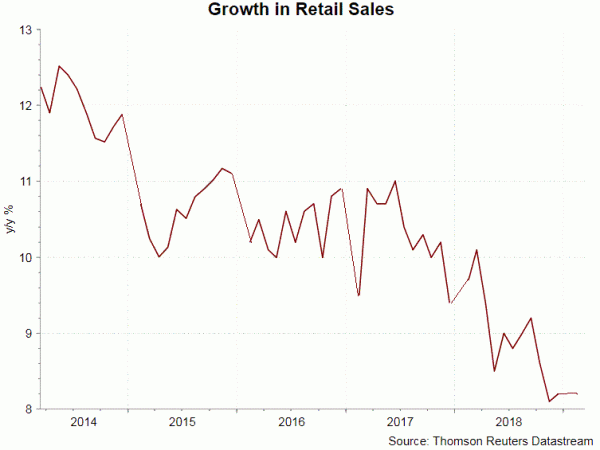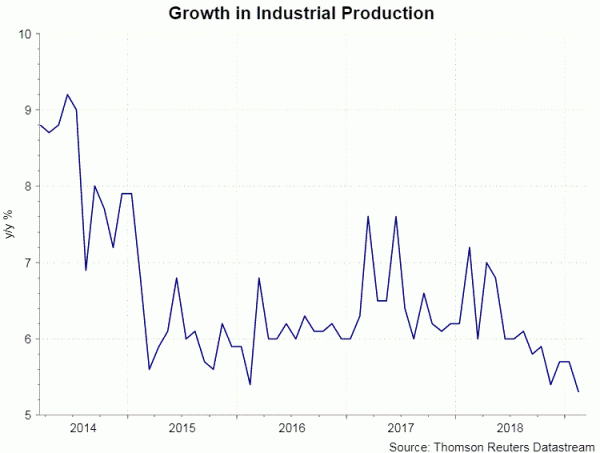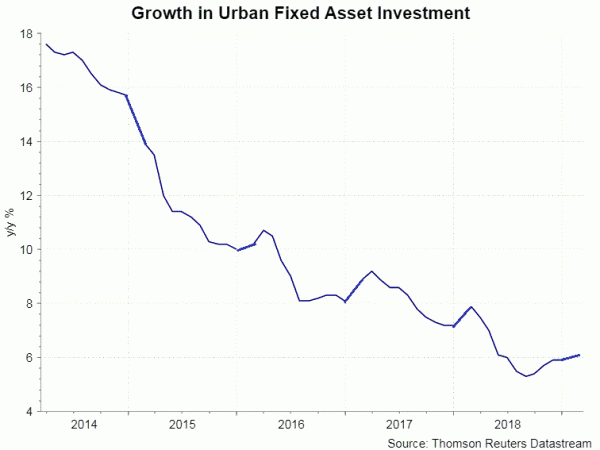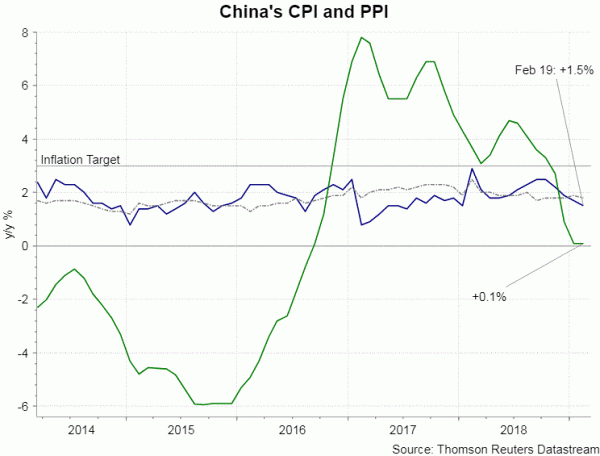China released its latest macroeconomic data for the first two months of the year. Due to Lunar New Year holiday, the January figures for retail sales, industrial production and fixed asset investment were not released. Despite signs of improvement, the set of data, together with inflation and trade reports released last week, affirmed slowdown in the country’s growth outlook. This also explains the urgency of stimulus measures announced at the National People’s Congress last week.
Retail sales grew +8.2% y/y in the first two months of the year, unchanged from December and higher than consensus of +8.1%. growth in industrial production fell to +5.3% y/y, compared with consensus of +5.55 and December’s +5.7%. Moreover, urban fixed asset investment increased +6.1% y/y, beating consensus of +65 and December’s +5.9%.
Inflation
Falling for four months in a row, headline CPI eased to +1.5% y/y in February from +1.7% a month ago. Excluding food prices, inflation stayed unchanged at +1.7% for the month, signaling that the general price level was dragged by food prices. Indeed, food prices grew only +0.7%, significantly lower than January’s +1.9%. Adjusting the distortion driven by Lunar New Year holiday, inflation in the first two months of the year was at +1.6%, easing from +2.2% during the same period last year. Food prices was at +1.3%, compared with +1.9% in the same period last year. PPI stayed unchanged at +0.1%, missing consensus of +0.2% as raw material prices remained in deflation.
Trade
China’s trade surplus narrowed significantly to US$ 4.1B in February. For the first two months of this year, trade surplus was US$ 43.3B, down from US$ 50.6B in the same period last year. This evidenced the slowdown in international trade even after partly excluding seasonal factors. Both imports and exports declined from a year ago. Imports dropped -5.2% while exports plunged -20.7%. For the first two years in 2019, exports and imports fell -4.6% and 3.1%, respectively, after rising +9.9% and +15.8% respectively last year. Country-wise, exports to the US remained weak, plunging -14% in the first two months of the year. Shipments to other countries also softened, as a result of global economic slowdown. For instance, exports to Japan and Hong Kong dropped -1.1 and +10.6%, respectively. Growth in shipments to the ASEAN moderated sharply to +2% for the period of January and February, compared with +12.5% in January. Similarly, exports to EU climbed slightly higher, by +2.4% during the period, compared with a +15.3% expansion in January. Weakness in imports evidenced the decline in domestic demand. The downtrend would likely continue in coming months, as China’s growth decelerates despite the government’s stimulus measures.
Government Policy
At the National People’s Congress (NPC) held last week, the government revised the GDP growth target to 6-6.5% for 2019. This was widely expected by the market. In order to cope with the slowdown, the government announced loosening measures in both fiscal and monetary policies. It pledged to adopt a “proactive, stronger, and more effective” fiscal policy, raising the budget fiscal deficit to 2.8% of GDP for this year, from 2.6% in 2018. Much of the fiscal easing would come from reduction in corporate tax and social insurance contribution (up to RMB 2 trillion). Meanwhile, the monetary policy would be “prudent”. With the term “neutral” again disappeared, it is obvious that the measures are tilted to the easing side. We expect RRR cut and reverse report to remain the major tools adopted by PBOC. Yet, the chance of rate cut is increasing as the growth outlook decelerates and expectations of Fed funds rate hike diminishes.
















